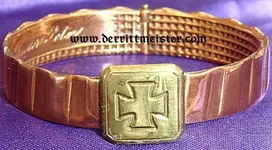UnderMiner
Silver Member
- Joined
- Jul 27, 2014
- Messages
- 3,950
- Reaction score
- 10,365
- Golden Thread
- 2
- Location
- New York City
- 🥇 Banner finds
- 2
- Detector(s) used
- Minelab Excalibur II, Equinox 800
- Primary Interest:
- All Treasure Hunting
Someone in my neighborhood threw this away today. I did alot of research on it for you guys. It is a French 75mm shell casing that has been made into an oil lamp.
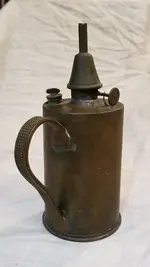
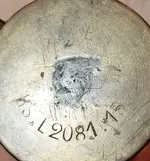
The shell casing was produced by the 'Ateliers de Construction de Rennes' company in 1915 in Rennes, France. The artillery shell it was meant to fire was used by the 'Canon de 75 Modele 1897' which was perhaps the single most common artillery cannon of the era.
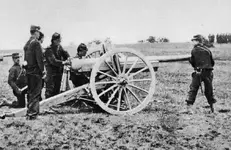
The flame mechanism is from a salvaged Pigeon Gasoline lamp, invented in 1884 by Charles-Joseph Pigeon (29 March 1838 – 18 March 1915) and showcased to much acclaim at the 'Exposition Universelle' in 1900 in Paris. The Pigeon Gasoline lamp offered the first widespread and practical use for gasoline before automobiles took over in the ensuing century.
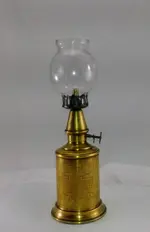

(a genuine Pigeon Gasoline lamp) Contrast with the handmade one, they look quite similar but the biggest difference is the original top unscrewed to accept fuel and to change the wick. The handmade one's top is soldered shut and only way to add fuel is threw a small screw cap to the side of it.
Edit: As pointed out by user Westfront the copper handle of this lamp is also a piece of salvaged military hardware. It is infact the copper driving band from the base of an artillery shell with the inside checkered pattern facing outward. Driving bands were most commonly used to make bracelets by the soldiers who would cut them off broken, or un-exploded shells.
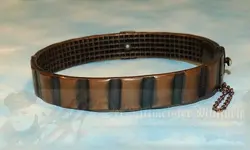
(Note the checkered pattern on the inside of this trench bracelet matches the same pattern on the handle of the lamp)
I can only speculate to the idea that this item was constructed by a French soldier some time around 1915 and that it served a practical use in lighting the trenches he was fighting in. It seems plausible that he found a broken Pigeon lamp in the rubble of the destroyed French countryside and rebuilt it using war debris.
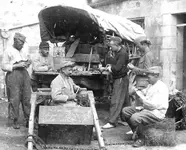
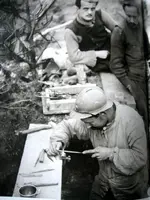
These French soldiers have dedicated an entire wagon for the purpose of building things from war debris.
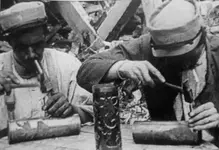
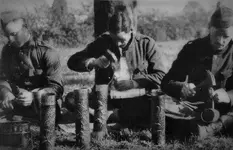
Here are some soldiers making vases from the casings.
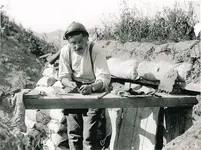
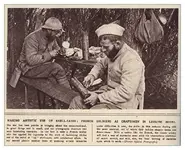
Newspaper article from the time showing French soldiers making things from shell casings. It appears the most common thing they made was vases, they also commonly made ash trays, letter openers, and lighters.


The shell casing was produced by the 'Ateliers de Construction de Rennes' company in 1915 in Rennes, France. The artillery shell it was meant to fire was used by the 'Canon de 75 Modele 1897' which was perhaps the single most common artillery cannon of the era.

The flame mechanism is from a salvaged Pigeon Gasoline lamp, invented in 1884 by Charles-Joseph Pigeon (29 March 1838 – 18 March 1915) and showcased to much acclaim at the 'Exposition Universelle' in 1900 in Paris. The Pigeon Gasoline lamp offered the first widespread and practical use for gasoline before automobiles took over in the ensuing century.


(a genuine Pigeon Gasoline lamp) Contrast with the handmade one, they look quite similar but the biggest difference is the original top unscrewed to accept fuel and to change the wick. The handmade one's top is soldered shut and only way to add fuel is threw a small screw cap to the side of it.
Edit: As pointed out by user Westfront the copper handle of this lamp is also a piece of salvaged military hardware. It is infact the copper driving band from the base of an artillery shell with the inside checkered pattern facing outward. Driving bands were most commonly used to make bracelets by the soldiers who would cut them off broken, or un-exploded shells.

(Note the checkered pattern on the inside of this trench bracelet matches the same pattern on the handle of the lamp)
I can only speculate to the idea that this item was constructed by a French soldier some time around 1915 and that it served a practical use in lighting the trenches he was fighting in. It seems plausible that he found a broken Pigeon lamp in the rubble of the destroyed French countryside and rebuilt it using war debris.


These French soldiers have dedicated an entire wagon for the purpose of building things from war debris.


Here are some soldiers making vases from the casings.


Newspaper article from the time showing French soldiers making things from shell casings. It appears the most common thing they made was vases, they also commonly made ash trays, letter openers, and lighters.
Last edited:
Upvote
34




